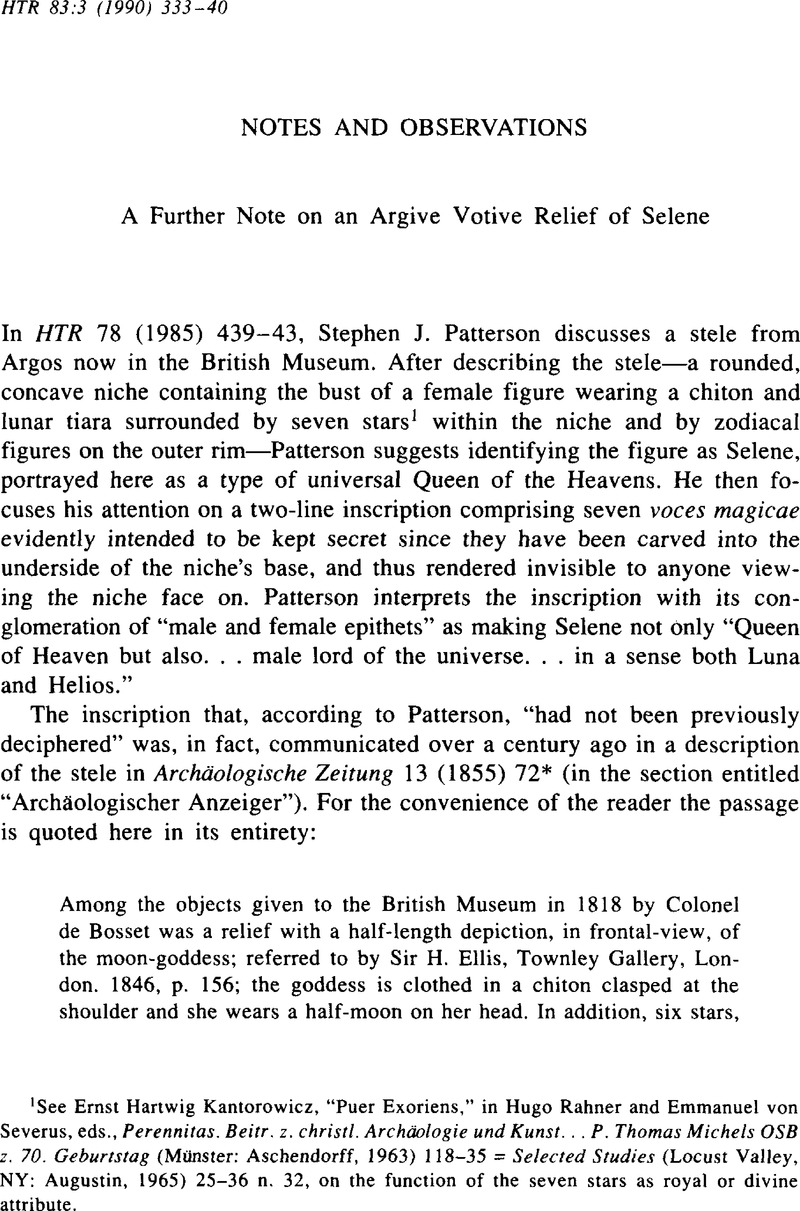No CrossRef data available.
Article contents
A Further Note on an Argive Votive Relief of Selene
Published online by Cambridge University Press: 10 June 2011
Abstract

- Type
- Research Articles
- Information
- Copyright
- Copyright © President and Fellows of Harvard College 1990
References
1 See Kantorowicz, Ernst Hartwig, “Puer Exoriens,” in Rahner, Hugo and Severus, Emmanuel von, eds., Perennitas. Beitr. z. christl. Archäologie und Kunst…P. Thomas Michels OSB z. 70. Geburtstag (Münster: Aschendorff, 1963) 118–35Google Scholar = Selected Studies (Locust Valley, NY: Augustin, 1965) 25–36 n. 32, on the function of the seven stars as royal or divine attributeGoogle Scholar.
2 = Ellis, H., The Townley Gallery of Classic Sculpture in the British Museum II (London, 1846) 156Google Scholar : “A Bas-relief, within a recess, representing the goddess Luna, surrounded on an outer edge by the signs of the Zodiac. It was presented to the Museum, in 1818, by Lieut.-Colonel De Bosset. It is two feet two inches high, by twenty-one inches in width.”
3 Delatte, Armand, “Etudes sur la magie grecque: un bas-relief gnostique,” Musee Beige 17 (1913) 321–37Google Scholar . He also mentions the stele briefly in Musee Beige 18 (1914) 18Google Scholar.
4 Cf. Bousset, Wilhelm, “Gnostiker,” in PW VII, 2, 1534–47Google Scholar , esp. 1535 . Fauth, Wolfgang, “Seth-Typhon, Onoel und der eselskopfige Sabaoth,” OrChr 57 (1973) 83Google Scholar . See now on the much misused term “gnostic,” Morton Smith, “The History of the Term Gnostikos,” in Layton, Bentley, ed., The Rediscovery of Gnosticism II (Leiden: Brill, 1981) 796–807Google Scholar.
5 The inscription also is quoted here in full with the following (mis)spellings: øιανøιπι, ανωøπα, αωαεκιετεαβαωø, αβωø επεαε.
6 SEG repeats the errors perpetrated by the Annual of the British School of Athens in the first line: øιανøιπι,ανωøπα, and attempts emending and explicating the second line as σωσεκακισ τν(?) εαβαωø [ε]αβιαιωø. επεεαε.
7 The number seven is frequently encountered in magical spells. Dawson, Warren R., Aegyptus 8 (1927) 97–107Google Scholar ; Sethe, Kurt, Von Zahlen und Zahlworten (Strassburg: Karl J. Trubner, 1916) 33–36Google Scholar ; Kees, Hermann, Der Gotterglaube im alien Agypten (2d. ed.; Berlin: Akademie-Verlag, 1956) 158ff.Google Scholar , discuss the number seven in ancient Egyptian contexts. For Greek and later Christian usages see Kalitsunakis, I. E., επτασικαι επενναι (Athens: Sakellarios, 1921) 107–94Google Scholar (non vidi); Andrian, Ferdinand von, “Die Siebenzahl im Geistesleben der VOlker,” Mitteilungen der anthropologischen Gesellschaft in Wien 31 (1901) 225–74Google Scholar ; Weinreich, Otto, Triskaidekadische Studien (RGVV 16.1) (Giessen: Topelmann, 1916) 91–100Google Scholar ; Procope-Walter, A., ARW 30 (1933) 35–36Google Scholar ; Eitrem, Sam, P. Oslo. I, 61–62Google Scholar ; Hasenfuss, J., “Zahlensymbolik,” LThK 10 (1965) 1303–5Google Scholar ; Dieterich, Karl, “Hellenistische Volksreligion u. byz.-neugriech. Volksglaube,” AITEAOX 1 (1925) 2–23Google Scholar , 2 (1926) 69.
8 Cf. Gignac, Francis T., A Grammar of the Greek Papyri of the Roman and Byzantine Periods I (Milan: Istituto editoriale cisalpino-La goliardica, 1976) 68–69Google Scholar . The converse phenomenon is attested in vulgar Latin or Greek contexts, e.g. Noember = November.




